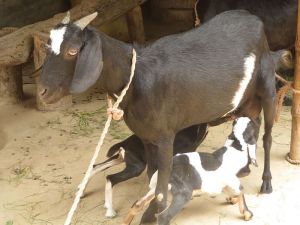Goat Development
| Embryology - 27 Apr 2024 |
|---|
| Google Translate - select your language from the list shown below (this will open a new external page) |
|
العربية | català | 中文 | 中國傳統的 | français | Deutsche | עִברִית | हिंदी | bahasa Indonesia | italiano | 日本語 | 한국어 | မြန်မာ | Pilipino | Polskie | português | ਪੰਜਾਬੀ ਦੇ | Română | русский | Español | Swahili | Svensk | ไทย | Türkçe | اردو | ייִדיש | Tiếng Việt These external translations are automated and may not be accurate. (More? About Translations) |
Introduction
The goat (Capra aegagrus hircus) was domesticated from the wild goat of Southwest Asia and Eastern Europe and is closely related to sheep. Goats, depending on both breed and nutritional status, reach puberty between 3 to 15 months of age and then have an estrous cycle with estrus (heat) every 21 days for 2 to 48 hours. The gestational period is about 150 days producing single, twins and triplet births.
- Links: 1942 early goat development
Some Recent Findings
|
| More recent papers |
|---|
|
This table allows an automated computer search of the external PubMed database using the listed "Search term" text link.
More? References | Discussion Page | Journal Searches | 2019 References | 2020 References Search term: Goat Development | Goat Embryology | Capra aegagrus hircus Development |
| Older papers |
|---|
| These papers originally appeared in the Some Recent Findings table, but as that list grew in length have now been shuffled down to this collapsible table.
See also the Discussion Page for other references listed by year and References on this current page.
|
Taxon
Kingdom: Animalia Phylum: Chordata Class: Mammalia Order: Artiodactyla Family: Bovidae Subfamily: Caprinae Genus: Capra Species: C. aegagrus Subspecies: C. a. hircus
Development Overview
References
- ↑ HosseinNia P, Hajian M, Jafarpour F, Hosseini SM, Tahmoorespur M & Nasr-Esfahani MH. (2019). Dynamics of The Expression of Pluripotency and Lineage Specific Genes in The Pre and Peri-Implantation Goat Embryo. Cell J , 21, 194-203. PMID: 30825293 DOI.
- ↑ Morató R, Hammami S, Paramio MT & Izquierdo D. (2019). Activin-A receptor expression patterns in prepubertal goat oocytes and derived embryos. Reprod. Domest. Anim. , 54, 804-807. PMID: 30786073 DOI.
- ↑ Boulanger L, Pannetier M, Gall L, Allais-Bonnet A, Elzaiat M, Le Bourhis D, Daniel N, Richard C, Cotinot C, Ghyselinck NB & Pailhoux E. (2014). FOXL2 is a female sex-determining gene in the goat. Curr. Biol. , 24, 404-8. PMID: 24485832 DOI.
- ↑ Singh R, Kumar K, Mahapatra PS, Kumar M, Agarwal P, Bhure SK, Malakar D, Bhanja SK & Bag S. (2014). Microarray analysis of gene expression in parthenotes and in vitro-derived goat embryos. Theriogenology , 81, 854-60. PMID: 24507961 DOI.
Reviews
Raudsepp T & Chowdhary BP. (2016). Chromosome Aberrations and Fertility Disorders in Domestic Animals. Annu Rev Anim Biosci , 4, 15-43. PMID: 26884101 DOI.
Articles
HosseinNia P, Hajian M, Tahmoorespur M, Hosseini SM, Ostadhosseini S, Nasiri MR & Nasr-Esfahani MH. (2016). Expression Profile of Developmentally Important Genes in preand peri-Implantation Goat Embryos Produced In Vitro. Int J Fertil Steril , 10, 310-319. PMID: 27695614
Hajian M, Hosseini SM, Ostadhosseini S & Nasr-Esfahani MH. (2016). Targeting the transforming growth factor-β signaling during pre-implantation development in embryos of cattle, sheep and goats. Growth Factors , 34, 141-8. PMID: 27442780 DOI.
Historic
Amoroso EC. Griffiths WFB. and Hamilton WJ. The early development of the goat (Capra hircus). (1942) J Anat. 76(4): 377–406.5. PMC1252677
Search Pubmed
Search Pubmed: Goat Development
External Links
External Links Notice - The dynamic nature of the internet may mean that some of these listed links may no longer function. If the link no longer works search the web with the link text or name. Links to any external commercial sites are provided for information purposes only and should never be considered an endorsement. UNSW Embryology is provided as an educational resource with no clinical information or commercial affiliation.
Animal Development
| Animal Development: axolotl | bat | cat | chicken | cow | dog | dolphin | echidna | fly | frog | goat | grasshopper | guinea pig | hamster | horse | kangaroo | koala | lizard | medaka | mouse | opossum | pig | platypus | rabbit | rat | salamander | sea squirt | sea urchin | sheep | worm | zebrafish | life cycles | development timetable | development models | K12 |
Glossary Links
- Glossary: A | B | C | D | E | F | G | H | I | J | K | L | M | N | O | P | Q | R | S | T | U | V | W | X | Y | Z | Numbers | Symbols | Term Link
Cite this page: Hill, M.A. (2024, April 27) Embryology Goat Development. Retrieved from https://embryology.med.unsw.edu.au/embryology/index.php/Goat_Development
- © Dr Mark Hill 2024, UNSW Embryology ISBN: 978 0 7334 2609 4 - UNSW CRICOS Provider Code No. 00098G

